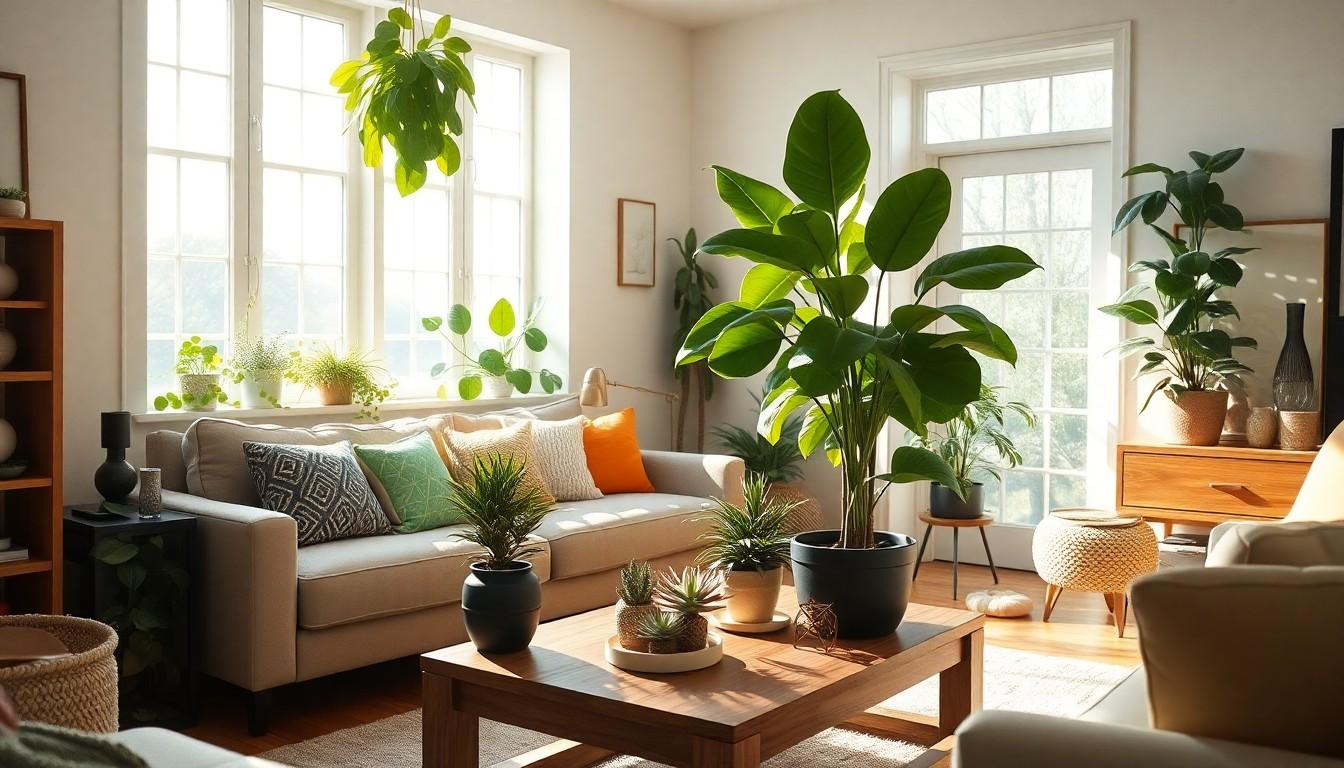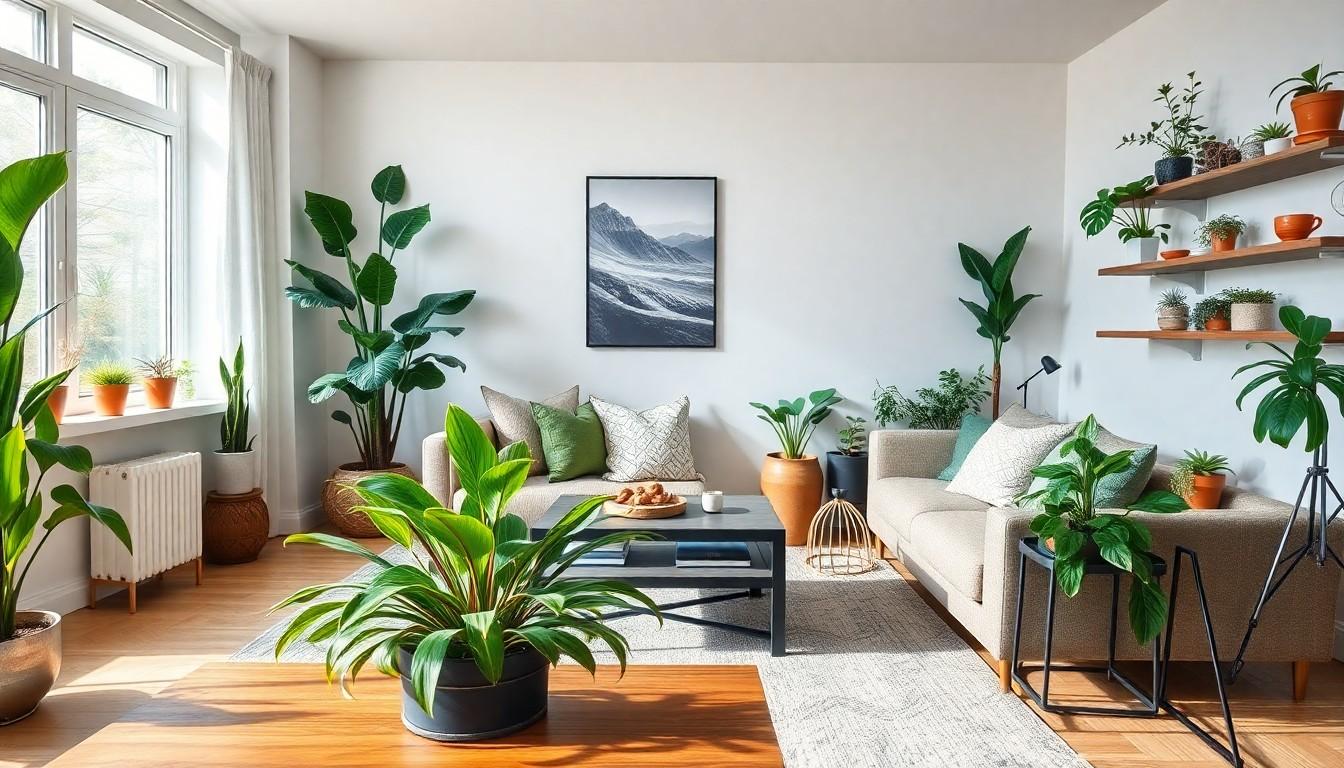Phone:
(701)814-6992
Physical address:
6296 Donnelly Plaza
Ratkeville, Bahamas.

House plants aren’t just pretty decorations; they’re like little green buddies that brighten up any space. From the low-maintenance succulents that thrive on neglect to the dramatic fiddle leaf figs that demand a bit more attention, there’s a plant for every personality and lifestyle. Who knew that adding a splash of greenery could boost mood, improve air quality, and even spark joy?
House plants vary widely in type, size, and care requirements. Commonly chosen plants include succulents, ferns, and flowering species, each suited to different environments and preferences.
Succulents thrive in dry conditions and require minimal watering. Examples include Aloe Vera and Echeveria. Ferns prefer humidity and indirect light, making them ideal for bathrooms or kitchens. Popular varieties are Boston Fern and Maidenhair Fern.
Flowering house plants bring vibrant colors indoors. African Violets and Peace Lilies bloom under suitable light and moisture conditions. They contribute not only aesthetic value but also improve air quality.
Low-light tolerant plants cater to those with less sunlight in their homes. Snake Plant and ZZ Plant perform well in shaded areas. They require little maintenance and adapt easily to various indoor conditions.
For those seeking larger species, consider tree-like plants such as Fiddle Leaf Fig and Rubber Plant. These plants can fill empty corners and provide dramatic focal points. However, they typically need more attention and care.
Herbs like Basil and Mint serve dual purposes. These plants can spice up culinary dishes while adding greenery to a home. They flourish with adequate sunlight and regular watering.
Diversity in house plants accommodates various lifestyles. Each type offers unique benefits, enabling individuals to select plants that resonate with their living space and personal preferences.

House plants provide numerous advantages that enhance both environments and well-being. Their positive impact on health and aesthetics makes them valuable additions to homes.
House plants improve indoor air quality by filtering out harmful pollutants. Studies show that plants like Spider Plant and Peace Lily eliminate toxins, creating cleaner breathing environments. They also increase humidity levels, which helps alleviate dry skin and respiratory issues. Research indicates that exposure to greenery reduces stress and anxiety, promoting relaxation. Moreover, studies confirm that certain plants can boost concentration and productivity, benefiting workspaces significantly.
House plants serve as natural décor elements that enhance the visual appeal of any room. With a variety of colors, textures, and sizes, they complement diverse interior styles. Plants like fiddle leaf figs and pothos act as striking focal points, while smaller succulents fit perfectly on shelves. Adding greenery creates a sense of tranquility, making spaces feel inviting. Incorporating various plants can transform ordinary areas into vibrant sanctuaries, fostering a connection with nature indoors.
House plants come in a variety of forms, each adding distinct character to indoor spaces. Selecting the right type enhances aesthetics and creates a healthy environment.
Foliage plants are known for their lush leaves and striking shapes. Examples include the Snake Plant and the Monstera, which thrive in various light conditions. Indoor enthusiasts appreciate their ability to tolerate neglect while still maintaining vibrant greenery. These plants filter air pollutants, making spaces healthier. Additionally, they adapt well to different room styles, from modern to rustic.
Flowering plants bring color and life indoors. African Violets and Peace Lilies are popular choices for adding visual interest. Blooming varieties offer seasonal flowers, enhancing indoor aesthetics throughout the year. These plants not only brighten spaces but also improve air quality, adding to their appeal. Care requirements can vary, but many adapt well to household routines.
Succulents and cacti are favorites for low-maintenance plant lovers. Varieties such as Echeveria and Aloe Vera require minimal watering. Their unique shapes and colors create captivating arrangements. Sunlight-loving, these plants thrive in bright spaces, making them perfect for windowsills. Both types increase humidity while purifying air, contributing to indoor health.
Each house plant comes with its own specific care requirements to thrive and flourish. Understanding these needs ensures the plants remain healthy and vibrant.
Light conditions play a crucial role in plant health. Succulents enjoy bright, indirect sunlight, while ferns thrive in partial shade. Snake Plants adapt well to low-light environments, making them ideal for darker spaces. Flowering plants like African Violets benefit from indirect light to bloom successfully. Understanding your plant’s light preferences helps in positioning them correctly to enhance growth.
Watering practices significantly impact plant vitality. Succulents require infrequent watering, allowing the soil to dry between sessions. Conversely, ferns favor consistently moist soil to maintain their lush foliage. A general rule involves checking for moisture in the top inch of soil before watering. Overwatering leads to root rot, so monitoring your plant’s specific needs prevents potential problems.
Soil quality and fertilization frequency affect plant health considerably. Well-draining soil benefits succulents and cacti exceptionally, promoting drainage and preventing water accumulation. In contrast, ferns prefer richer, moisture-retaining potting mix. Fertilization should occur during the growing season, using balanced fertilizers every four to six weeks. Adjusting soil types and nutrition according to plant variety supports robust growth and overall well-being.
Selecting the right house plant involves considering various factors, including size and placement. Understanding these aspects improves the overall harmony between the plant and the living environment.
Size plays a crucial role in plant selection. Smaller plants like succulents work well on shelves and tables, while larger ones can create striking visual anchors in spacious areas. Assessing room dimensions helps in determining the appropriate plant size. For example, a Fiddle Leaf Fig may fit nicely in a corner of a living room, whereas a short Snake Plant suits narrow spaces. The growth potential of each plant type influences decisions too, as some may outgrow their initial spots. Planning for future growth provides longevity and satisfaction.
Placement significantly affects plant health and aesthetics. Choosing bright, indirect sunlight locations benefits succulents, while shade-loving ferns thrive in darker corners. Considering air circulation is important; placing plants in areas with good airflow prevents mold or insect problems. Grouping plants adds visual interest but ensure that larger plants do not overshadow smaller ones. Elevating pot heights creates depth and enhances the overall look. Additionally, moving plants according to seasonal light variations ensures each plant receives adequate sun throughout the year.
House plants offer an incredible opportunity to enrich living spaces while promoting health and well-being. With so many varieties available, there’s a perfect plant for every personality and lifestyle. Whether someone prefers the low-maintenance charm of succulents or the striking presence of a Fiddle Leaf Fig, these green companions can transform any room into a vibrant sanctuary.
Selecting the right house plant not only enhances aesthetics but also contributes to a healthier indoor environment. By understanding the care requirements and ideal placements for different plants, individuals can create a flourishing indoor garden that brings joy and tranquility. Embracing the diversity of house plants is a rewarding journey that connects people with nature in their own homes.